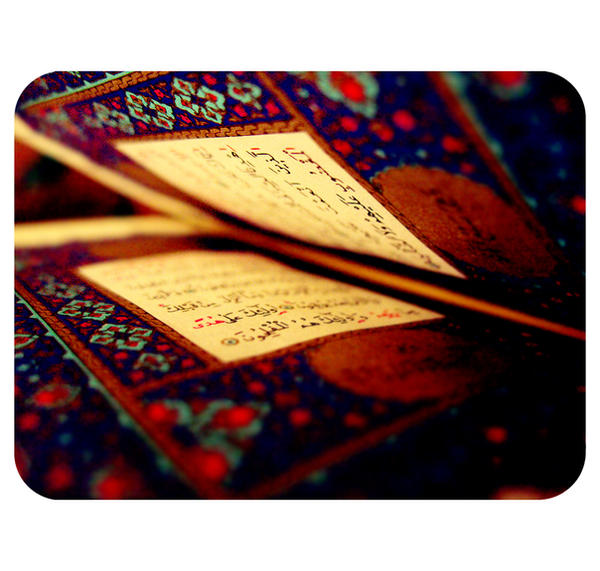
“1. Alif. Lám. Mím.
2. This is the Book; in it is guidance sure, without doubt, to those who fear Allah;
3. Who believe in the Unseen, are steadfast in prayer, and spend out of what We have provided for them;
4. And who believe in the Revelation sent to thee, and sent before thy time, and (in their hearts) have the assurance of the Hereafter.
5. They are on (true) guidance, from their Lord, and it is these who will prosper.”
(2:1,2,3,4,5)
~~~~~~~~~~~~~~~~~~~~~~~~~~~~~~~~~~~~~~~~~~~~~
Jika keluar ke bandar, saya memang jarang lepaskan peluang untuk berkunjung ke kedai-kedai buku. Jadi saya telah melihat berbagai-bagai jenis buku dan gaya penulisan (alhamdulillah), dan tentang hal itulah yang mencetuskan topik ini: “Hati-hati bila nak beli buku agama”.
Ini kerana saya dapati ada orang awam yang membeli buku hanya kerana tertarik dengan tajuk buku sahaja sedangkan dia tidak berfikir pun tentang tahap ketulenan dan kesahihan ilmu yang terdapat dalam buku yang ingin dibelinya.
Apa masalahnya sehingga perlu berhati-hati pula?
Begini, antara masalah-masalah yang dapat dilihat pada sesetengah buku-buku agama adalah seperti berikut:
- Fakta-fakta Islam yang terkandung dalam buku tersebut tidak disertakan dari mana dalilnya atau kitab apa yang dijadikan rujukan. *(dalam buku yang bagus biasanya terdapat footnote yang menyebut tentang sumber-sumber yang digunakan oleh penulis dalam memasukkan sesuatu hukum\fatwa\fakta Islam)
- Penulisan mengandungi unsur emosi bukannya ilmiah.
- Banyak dimasukkan hadith-hadith dan zikir-zikir spesifik dalam sesuatu ibadah tetapi tidak disebut sumbernya. Para pembaca buku perlu berwaspada dengan zikir-zikir dalam ibadat yang direka-reka oleh manusia, takut-takut ia menukar cara dan lafaz bacaan seperti mana yang diajar Rasulullah, contoh ikutan terbaik buat kita.
- Malah, kadang-kadang diajar juga amalan ibadat pelik-pelik, di mana tidak disebut dengan dalil dan sumber manakah penulis mendapat tahu hal tersebut.
- Kadang-kadang walaupun disertakan hadith-hadith, penulis tidak menyatakan status hadith tersebut sama ada dari segi siapa periwayatnya (Bukhari, Muslim, Tirmidhi etc), dan kategori hadith tersebut (Sahih, Hasan etc).
- Perkara yang disampaikan oleh penulis bukannya hujah ilmiah, sebaliknya hal-hal karut-marut yang tidak ada asasnya dalam nas-nas sahih.
- Penulisan yang bersikap sempit (jumud), iaitu penulis tidak mempamerkan hujahnya dengan jelas, terang dan selaras dengan dalil-dalil yang kukuh saling menyokong; tetapi sebaliknya berhujah dengan alasan yang tidak kuat, dan kerap kali tidak berdalil atau dalilnya ialah hadith yang lemah. Ini selalu dijumpai dalam buku-buku cara ibadat.
- Penulis bertindak menyerang peribadi seseorang individu yang tidak sependapat dengannya. Sepatutnya dia hanya berbahas (secara ilmiah bukan emosi) untuk melawan hujah individu itu sahaja, bukannya merosakkan dan merendah-rendahkan maruah orang lain.
Kriteria-Kriteria Penting Bila Nak Beli Buku Agama
Bila hendak beli buku agama, pastikanlah hal-hal berikut supaya ilmu agama yang diperolehi itu lebih selamat untuk diamalkan:
- Buku tersebut mengandungi fakta-fakta dalam syariat Islam yang disokong oleh dalil-dalil daripada Al-Quran dan Hadith.
- Hadith-hadith yang digunakan dimasukkan sekali rujukannya daripada kitab mana (contoh: Hadith no. 1243 dalam Sahih Bukhari, Hadith no. 116 dalam Kitab Sahih Al-Huffaz, m/s 234 dari buku “Introduction To Islam” dan sebagainya).
- Pastikan dalil-dalil yang disertakan mempunyai penerangan yang jelas dan logik. Jika dalil-dalil itu agak sukar untuk difahami, adalah bagus jika buku itu mengandungi tafsiran daripada para ulama’ pentafsir Quran dan Hadith.
- Sungguhpun jika dalil Al-Quran dan As-Sunnah ada dimasukkan, pembaca seeloknya tetap perlu menganalisa buku itu dan elakkan menerima secara membuta-tuli sesuatu hal, melainkan jika sudah benar-benar yakin dengan kekuatan hujah ilmiah yang terkandung dalam buku tersebut. *(Antara teknik menganalisa buku yang baik ialah: membandingkan hujah dalam buku tersebut dengan hujah-hujah dalam buku-buku agama lain yang dipercayai. Kemudian jika terdapat perbezaan pendapat, cuba fikirkan sebabnya, dan lebih baik anda pergi bertanya ustaz yang pakar dalam hal tersebut untuk lebih pasti.)
- Hujah (selain hal-hal ghaib) yang digunakan oleh penulis dapat diterima akal logik.
- Tentang hal-hal ghaib, mesti pastikan terdapat ayat Al-Quran dan hadith-hadith sahih yang menjadi bukti bagi hal ghaib tersebut. Untuk lebih selamat, pastikan buku tersebut mengandungi tafsiran-tafsiran para ulama’ tentang hal ghaib itu. *(sebenarnya hal-hal ghaib tidak patut untuk dibahaskan dengan mendalam kerana hal-hal ghaib memang manusia biasa tak nampak. Jadi cukuplah kita beriman dengan apa sahaja yang disebut dalam Al-Quran dan As-Sunnah daripada kita sibuk membuat sangkaan-sangkaan tentang hal-hal ghaib ini.)
- Semakin banyak pendapat para ulama’ muktabar terdahulu dan mutakhir dimasukkan penulis ke dalam buku tersebut, semakin baguslah buku itu untuk dibeli, kerana hujah yang disampaikan akan jadi lebih kuat dan menyakinkan.
- Tidak ada unsur-unsur khurafat dan dongeng dalam usaha penulis untuk menyampaikan sesuatu maklumat dalam buku tersebut.
- Penulis tidak menunjukkan ketaksuban kepada ideologi atau gaya hidup mana-mana individu melainkan kepada Rasulullah s.a.w sahaja.
- Penyampaian isi buku tidak berbelit-belit.
- Gaya penulisan tidak menunjukkan unsur-unsur ego dan lagak, sebaliknya penulisan itu kelihatan seperti cenderung untuk berdakwah kepada para pembaca bukannya untuk menghentam individu.
Semoga semua ini dapat membantu kita untuk membeli buku-buku agama yang lebih terjamin kesahihannya dan lebih selamat untuk diamalkan isinya. Insha Allah!
~~~~~~~~~~~~~~~~~~~~~~~~~~~~~~~~~~~~~~~~~~





















